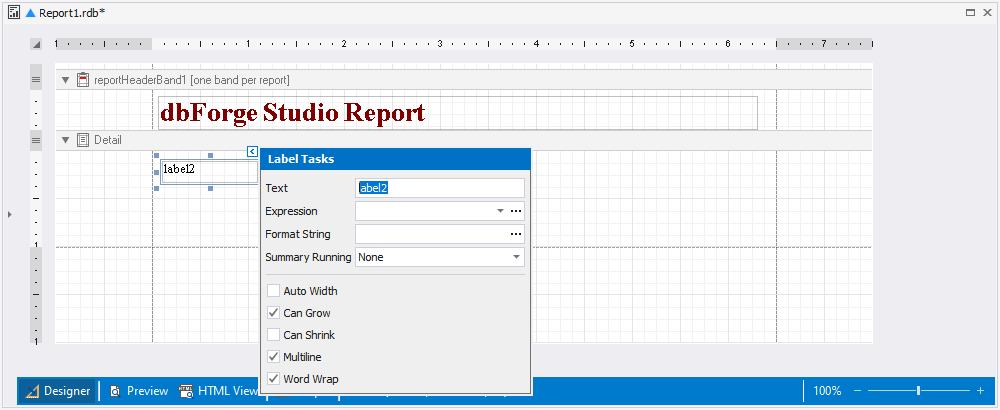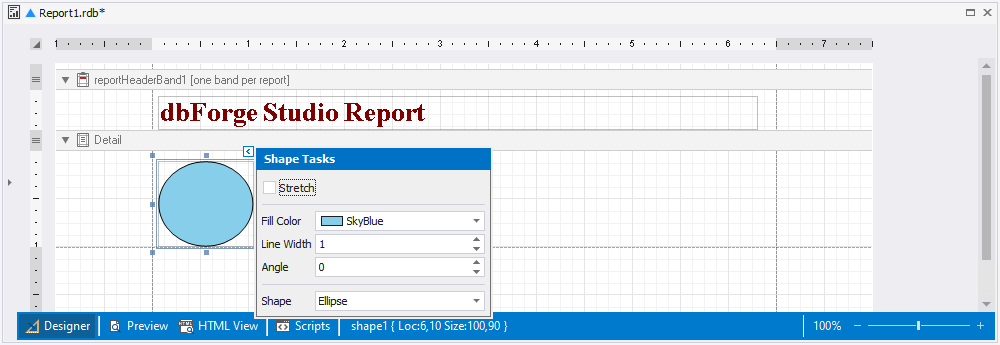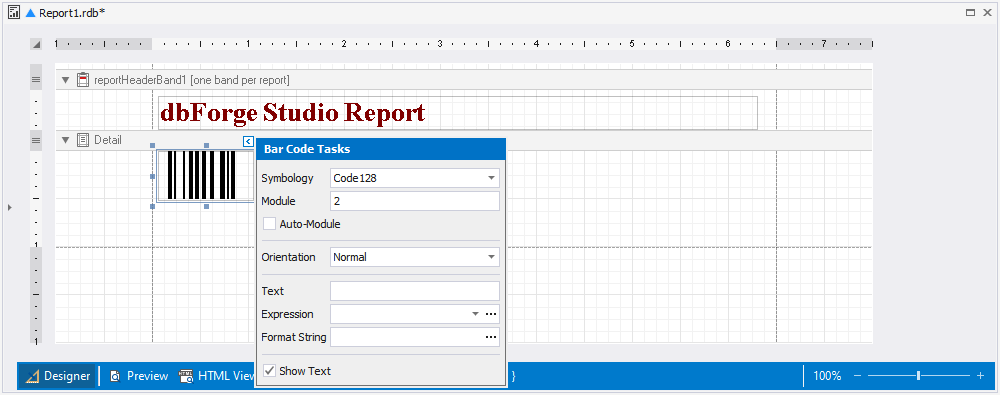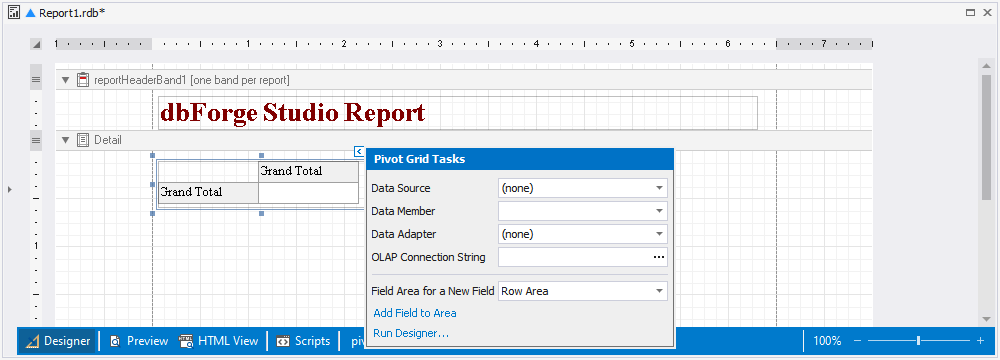Report controls
Last modified: April 5, 2024
The controls provided by dbForge Studio for MySQL enable users to develop reports utilizing information stored in SQL Server databases. With an intuitive graphical interface, these controls allow designing reports with tables, charts, graphs, and other tools for visualizing data.
To add a new control to the report, use either of the following options:
- Drag an item from the Toolbox pane to the report band.
- Use the Data Source window. When any data field is dragged to a report, a new appropriate report control is added and automatically bound to the specified data field.
Types of controls
There are the following report controls in dbForge Studio for MySQL:
- Pointer
- Label
- Check Box
- Rich Text
- Picture Box
- Panel
- Table
- Character Comb
- Line
- Shape
- Bar Code
- Chart
- Gauge
- Sparkline
- Pivot Grid
- Table of Contents
- Page Info
- Page Break
- Cross-band Line
- Cross-band Box
Pointer

The Pointer control enables you to adjust the size, configurations, and additional attributes of the pre-existing controls present on a report worksheet.
Label

The Label control allows displaying descriptive text in a report. By double-clicking on the control, you can modify the text using the in-place editor. Furthermore, the smart tag menu can be utilized to execute the following operations on the control:
- Modify the text of the control.
- In the Expression field, associate the control with data from a report’s data source.
- Change the appearance of the control’s data using the Format String editor.
- Compute a summary for a group, report, or page with the help of the Summary Running editor.
- Resize the control to fit its content by selecting the Auto Width checkbox.
- Adjust the height of the control by selecting or clearing the Can Grow and Can Shrink checkboxes.
- Activate the multiline text or word wrap feature.

Check Box

The Check Box control lets you display checkboxes in a report.
To use the control, double-click it. You can use the smart tag menu to perform various operations on the control, such as:
- Indicate the control’s state by selecting either Checked, Unchecked, or Indeterminate from the Check Box State drop-down list.
- Associate the control with data from the data source of a report in the Expression field.
- Change the control caption in the Text field.

Rich Text

The Rich Text control empowers the ability to showcase formatted text within a report, leading to enhanced flexibility and aesthetic appeal.
To modify the control caption in the in-place editor, just double-click the control. Additionally, you can use the smart tag menu to perform the following operations over the control:
- Upload data from .rtf, .docx, .html, and .htm files.
- Link the control to data from a report’s data source containing RTF or HTML content using the Rtf Expression and Html Expression fields/editors respectively.
- Adjust the height of the control by selecting or clearing the Can Grow and Can Shrink checkboxes.

Picture Box

The Picture Box control permits you to insert images into a report for added context and visual representation.
With the smart tag menu of the control, you can:
- Upload the image to the control in the Image Source field.
- Associate the control with data from the data source of a report in the Expression field.
- Specify the path to the image in the Image URL field.
- Adjust the size of the image in the Sizing field.
- Manage the alignment of the image.

Panel

The Panel control provides an identifiable grouping for other controls.

Table

The Table control lets format and display data in a tabular form.
By double-clicking the control, you can edit the control text using the in-place editor. Additionally, the smart tag menu permits you to perform separate actions on each cell:
- Change the text of the control.
- Associate the control with data from the data source of a report in the Expression field.
- Format control data with the help of the Format String editor.
- Compute a summary for a group, report, or page with the help of the Summary editor.
- Adjust the width of the control to its content by selecting the Auto Width checkbox.
- Enable the multiline text or word wrap.

Character Comb

The Character Comb control permits you to divide a string into separate cells, where each cell holds a single character.
You can double-click the control and modify the control text in the in-place editor or use the smart tag menu to perform the following operations over the control:
- Modify the text of the control.
- Link the control with data from the data source of a report in the Expression field.
- Adjust the height of the control by selecting or clearing the Can Grow and Can Shrink checkboxes.
- Format control data with the help of the Format String editor.
- Compute a summary for a group, report, or page with the help of the Summary Running editor.
- Resize the control to fit its contents by selecting the Auto Width checkbox.
- Activate the option for multiline text or word wrap.

Line

The Line control allows organizing report sections by visually separating them with lines.
The smart tag menu enables you to personalize the line’s visual aspects, including drawing horizontal, vertical, or diagonal lines, choosing from solid, dashed, dotted, or mixed line styles, and setting the line width and vertical anchoring style.

Shape

The Shape control lets you insert arrows or circles to a report.
To modify the appearance of a graphic element, you can use the smart tag menu:
- Stretch a shape in case its size changes by selecting the Stretch checkbox.
- Specify the background color.
- Configure the outline width.
- Set the degree of rotation for the graphic element.
- Select the shape of the graphic element.

Bar Code

The Bar Code control enables you to show barcodes and generate them based on specified data.
The smart tag menu allows setting barcode properties:
- Select a barcode type from the Symbology drop-down list.
- Enter a specific barcode width value in the Module field.
- Select the Auto Module box to have the barcode width set automatically.
- Specify the barcode orientation.
- Insert the barcode text.
- Associate the control with data from the data source of a report in the Expression field.
- Use the Format String editor to format control data.
- Select the Show Text checkbox to show the barcode text.

Chart

The Chart control allows you to display report data as a diagram, providing a visual representation of data relationships and trends.
Dragging the Chart control onto the band will open the Chart Designer, allowing you to add a chart and adjust its configurations.

Once the chart has been added, you can use the smart tag menu to carry out the following actions on the control:
- Bind a chart to data by using the Data Source field.
- Specify the data source for a chart in the Data Member and Data Adapter fields.
- Open Chart Designer to modify the chart settings. For this, click Run Designer.
- Customize a series by clicking Series.
- Click Annotations to add an annotation and adjust its settings.
- Customize the palettes by clicking Palettes.
- Export a chart to an .xml file.
- Load a chart as an .xml file.

Gauge

The Gauge control enables you to insert graphical gauges to your report, presenting a straightforward and concise graphical depiction of data patterns.
You can use the smart tag menu to customize the gauge:
- Specify a view type: linear or circular.
- Define the view style for a linear gauge as either horizontal or vertical, and for a circular gauge, select from full, half, quarter left, quarter right, or three fourths.
- Specify a view theme: flat light or flat dark.
- Enter the values for both the actual and target to be shown on the gauge.
- Link the values to the data source in their respective Expression fields.
- Set the maximum and minimum values for a gauge.

Sparkline

The Sparkline control provides you with the capability to present a compact chart for displaying the data flow for every row in a report. This control enables efficient visualization of data trends while conserving space.
With the smart tag menu, you can perform the following actions on the sparkline:
- Bind the control to data.
- Enter the name of the data member assigned to a sparkline.
- Select the data field that will be used to obtain the values.
- Customize the sparkline view: line, area, bar, or winloss.

Pivot Grid

The Pivot Grid control permits you to show and edit pivot tables, allowing for a more flexible and dynamic approach to data analysis.
You can perform such operations with the smart tag menu:
- Link a pivot grid to data by using the Data Source field.
- Specify the data source for a pivot grid in the Data Member and Data Adapter fields.
- Set the connection string for the Online Analytical Processing (OLAP) data source that the pivot grid will use.
- Select the required location of a new field (Row Area, Column Area, Filter Area, and Data Area) from the Field Area for a New Field drop-down menu.
- Add fields by clicking Add Field to Area.
- Open Chart Designer to modify the chart settings. For this, click Run Designer.

Table of Contents

The Table of Contents control lets generate a table of contents for the report, providing the reader with easy navigation and reference markers.
To include the Table of Contents control, drag the item from the Toolbox pane to the ReportHeader band. Using the smart tag menu, you can add an additional level to the table of contents.

Page Info

The Page Info control allows you to show additional information on your report’s pages, such as page numbers, dates, or other relevant data.
With the smart tag menu, you can:
- Facilitate the display of additional details on pages within a report, encompassing page numbers, dates, and other relevant information.
- Specify a start page number.
- Utilize the Text Format String editor to format the control data.
- Set page numbers for the group, if it exists, in the Running Band field.
- Specify a type of vertical anchoring for the control.

Page Break

The Page Break control lets you add a page breakdown into your report, providing added organization and separation of report sections.

Cross-band Line

The Cross-band Line control permits you to draw lines on several channels and across the whole page, providing a flexible and customizable way to add visual elements to your report.
You can customize the control’s style and choose a vertical anchoring type with the help of the smart tag menu.

Cross-band Box

The Cross-band Box control enables you to draw rectangles across multiple channels and the entire page, delivering a versatile and adaptable method for incorporating visual components into your report.
You can use the smart tag menu to specify a type of vertical anchoring of the control.

Want to find out more?
Overview
Take a quick tour to learn all about the key benefits delivered by dbForge Studio for MySQL.
All features
Get acquainted with the rich features and capabilities of the tool in less than 5 minutes.
Request a demo
If you consider employing this tool for your business, request a demo to see it in action.
